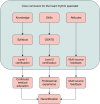2024 updated European Heart Rhythm Association core curriculum for physicians and allied professionals: a statement of the European Heart Rhythm Association of the European Society of Cardiology
- PMID: 39298665
- PMCID: PMC11528301
- DOI: 10.1093/europace/euae243
2024 updated European Heart Rhythm Association core curriculum for physicians and allied professionals: a statement of the European Heart Rhythm Association of the European Society of Cardiology
Abstract
Heart rhythm management is a continuously evolving sub-speciality of cardiology. Every year, many physicians and allied professionals (APs) start and complete their training in cardiac implantable electronic devices (CIEDs) or electrophysiology (EP) across the European Heart Rhythm Association (EHRA) member countries. While this training ideally ends with an EHRA certification, the description of the learning pathway (what, how, when, and where) through an EHRA core curriculum is also a prerequisite for a successful training. The first EHRA core curriculum for physicians was published in 2009. Due to the huge developments in the field of EP and device therapy, this document needed updating. In addition, a certification process for APs has been introduced, as well as a recertification process and accreditation of EHRA recognized training centres. Learning pathways are more individualized now, with Objective Structured Assessment of Technical Skills (OSATS) to monitor learning progression of trainees. The 2024 updated EHRA core curriculum for physicians and APs describes, for both CIED and EP, the syllabus, OSATS, training programme and certification, and recertification for physicians and APs and stresses the importance of continued medical education after certification. In addition, requirements for accreditation of training centres and trainers are given. Finally, suggested reading lists for CIED and EP are attached as online supplements.
Keywords: Arrhythmias; Cardiac implantable electronic devices; Certification; Curriculum; Education; Invasive electrophysiology.
© The Author(s) 2024. Published by Oxford University Press on behalf of the European Society of Cardiology.
Conflict of interest statement
Conflict of interest: none declared.
Figures


References
-
- Raatikainen MJP, Arnar DO, Merkely B, Nielsen JC, Hindricks G, Heidbuchel H, et al. A decade of information on the use of cardiac implantable electronic devices and interventional electrophysiological procedures in the European Society of Cardiology Countries: 2017 report from the European Heart Rhythm Association. Europace 2017;19:ii1–90. - PubMed
-
- Merino JL, Arribas F, Botto GL, Huikuri H, Kraemer LI, Linde C, et al. Core curriculum for the heart rhythm specialist. Europace 2009;11:iii1–26. - PubMed
-
- Tzeis S, Theuns DA, Earley M, Merino JL, Leclercq C. EHRA certification: a 15-year journey of attesting excellence in arrhythmia healthcare. Europace 2022;24:175–8. - PubMed
-
- EHRA Certification Web Page. https://www.escardio.org/Education/Career-Development/Certification/EHRA... (7 December 2023, date last accessed).
MeSH terms
LinkOut - more resources
Full Text Sources
Miscellaneous

